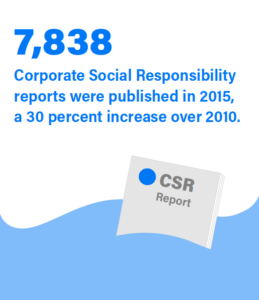
Fixing the Leak in Water Efficiency with Data
Amy Hou | November 30, 2017 | Energy & Sustainability
Many enterprises are beginning to account for their triple bottom line — the financial, social, and environmental impacts of their business — but they’re missing one crucial asset: water efficiency data.
Generating Shared Value
Triple bottom line decisions are based not only on financial benefit, but also on societal and environmental impact. Impact on the environment and society typically centers on resource scarcity issues and sustainability, such as water efficiency. Firms that have embraced triple bottom line principles also strive to make a positive impression and build a reputation for being good corporate citizens. The corporate social responsibility (CSR) mentality builds goodwill with customers and helps to differentiate from competitors.
Building on the triple bottom line, Michael Porter and Mark Kramer introduced the concept of “shared value,” wherein companies generate economic value in a way that also produces benefits for society by addressing its challenges.
A shared value approach can involve reconceiving products and markets toward sustainability, redefining productivity in the value chain, and supporting community partners. In this way, companies can bring business and society back together.
Data-Driven Transparency
Firms already recognize that transparency through public disclosure is one of the most effective ways to increase its level of corporate responsibility and generate shared value. In 2015, 7,838 corporate social responsibility (CSR) reports were published, up 30 percent over 2010. These reports typically include data on water consumption and progress towards reduction goals. Additionally, PwC found that 64 percent of CEOs surveyed in 2016 agreed that CSR is core to their business, and not a “stand-alone program.”
Get our latest white paper to learn how water data-as-a-service can help your sustainability program float.
Recently, the Sustainability Accounting Standards Board (SASB), a non-profit that seeks to standardize non-financial reporting, welcomed former New York Mayor Michael Bloomberg as Chair and former Securities and Exchange Commission head Mary Schapiro as Vice Chair. This power couple chosen to lead SASB demonstrate the combined importance of fiscal savvy and data-driven transparency when it comes to sustainability reporting. To keep the momentum of non-financial corporate reporting going, tools like an automated feed of water data can help by simplifying the reporting process while aligning with the data-driven standardization goal of industry groups like SASB.
One example of a strategy proven to produce success around transparent water reporting is conducting a product life-cycle analysis. For example, Levi Strauss & Co. sought to better understand how much water is required to make a single unit of its product. The company found that the total life-cycle of a single pair of jeans requires 3,781 liters of water. About one-quarter of this water consumption is from consumer care: washing the jeans once they have been purchased. But, the majority of water is consumed by Levi Strauss & Co. and its suppliers.
Transparency through public disclosure is one of the best ways that a firm can increase its level of corporate responsibility.
Beverage companies Nestle Waters and Coca-Cola also have conducted data-driven analyses of the water used to make their products, making the results publicly available. Nestle reported that it takes 1.39 gallons of water to produce 1 gallon of Nestle bottled water, on par with the industry average. Coca-Cola went one step further and reported that the company brought its water cost per unit down from 2.7 liters in 2004 to 1.96 liters in 2017. Life-cycle analyses are a tangible way to demonstrate quantified progress in water reduction goals to external stakeholders. But, they require a substantial amount of data.
These enterprises needed to collect very granular water use data in order to meet reporting requirements, a task that can be expedited by automated collection. As more companies, even those without water-intensive operations, are expected to publish detailed water life-cycle analyses, they can use an automated feed of water billing data to conduct such efforts more cost effectively.
Better Access to Water Efficiency Data
The recent 2030 Water Resources Group report, “Charting Our Water Future,” notes of large water consuming enterprises: “The transparency provided by the demand and supply analysis, and by the cost curves on where they are most exposed to the risk of water scarcity, and what their options are to mitigate the risk, will assist such companies in making the case for investing in water security solutions.” The report encourages enterprises to collect and analyze water consumption data as a first step to identifying water risks.
Through the process of analyzing water efficiency, CSR professionals are coming to the realization that manually collecting billing data from disparate sources leads to an unnecessary headache. In order to meet the level of transparency that consumers and investors expect, automated and standardized access to consumption data is crucial.
Many enterprises recognize the risks that water will have on their operations, and are subsequently taking action on the principles of shared value. In some cases, organizations are already aggressively reducing water consumption, setting public targets for more reductions in the future, and reaping a variety of reputational benefits from these actions. Regardless of how progressive an enterprise’s water conservation strategy is today, an automated and standardized feed of water billing data is the foundational first step.
Want to learn more? Contact us to see how automated water data can help your business.
Related Resources:
- Using Data to Establish a Baseline of Water Use
- Automotive Supplier Mubea Unlocks a Flood of Water Savings
- Webinar: Sustainability Programs — Surviving or Thriving?
If you like what you’re reading, why not subscribe?
About Amy Hou
Amy Hou is a Marketing Manager at Urjanet, overseeing content and communications. She enjoys writing about the latest industry updates in sustainability, energy efficiency, and data innovation.
You May Also Like
Support Business Continuity by Embracing ESG
Honor Donnie | March 18, 2022 | Energy & Sustainability

